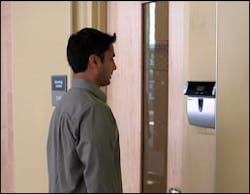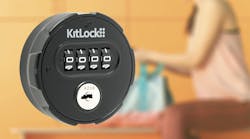When you are running a research facility full of expensive equipment and sensitive information, controlling access and egress takes on new proportions. At the Nanofabrication Facility at the University of California Santa Barbara (UCSB), Laboratory Manager Jack Whaley wears many hats - one being to keep track of traffic in the lab facility. After an extensive review and evaluation of access control systems, Mr. Whaley selected Panasonic's BM-ET300 Iris Readers based on their ability to deliver the highest forms of personnel authentication and identification.
The UCSB Nanofabrication Facility offers a full range of processes in compound semiconductor-based device fabrication to the scientific and research communities. In laymen's terms, the facility engineers new or improved materials on the scale of individual atoms. The science - called nanotechnology - is a relatively young discipline with numerous applications across a broad range of industries. For example, nanotechnology has produced tiny lenses used in fiber optic switching devices, created water resistant textiles, improved sporting equipment - like golf balls with less tendency to hook - and developed new substances that are 100 times stronger than steel at a fraction of the weight.
Much of the research conducted at the UCSB Nanofabrication Facility is privately funded by organizations that have invested heavily in the development of breakthrough materials. Keeping research safe from inquisitive eyes and competitors calls for tight security. "We looked at most other biometric access control systems and card readers to evaluate which access control technology offered the most accurate forms of authentication and identification," said Mr. Whaley. "The Panasonic BM-ET300 Iris Recognition Readers delivered the performance characteristics we wanted to tightly monitor and control access to the facility and internal labs."
"In addition, we use the Panasonic iris readers to accurately track and record time and attendance for billing purposes at the facility," said Mr. Whaley.
Several Panasonic BM-ET300 Iris Recognition Readers are deployed at the UCSB Nanofabrication Facility. One system is located at the main entrance to the facility with two additional units located at the entrance and exit of the lab area. Panasonic's BM-ET300 features iris reader technology which is quickly gaining acceptance as the "Gold Standard" in biometrics. The technology is non-invasive and does not require any contact with the user. The readers are easy to use and can be used independently of other forms of ID such as cards, tokens or keys, which can be lost or stolen. Most importantly, iris recognition readers are virtually 100% accurate with an EER of 99.9999992%.
Panasonic's BM-ET300 Iris Recognition Readers feature a multi-camera system with "one glance" authentication along with a self-prompting audio and visual user guidance system for fast and easy operation. For added reliability versus PC-driven biometrics devices, the BM-ET300 incorporates an embedded processor with real-time operation allowing its use in a systems configuration. The Panasonic BM-ET300 also features a Wiegand input and output for easy integration with virtually any access control system. The UCSB Nanofabrication Facility integrated its BM-ET300s with AMAG Technology's access control software.
"People cannot lose their iris nor have it stolen or replicated like conventional cards or proximity devices," continued Mr. Whaley. "We have a high level of confidence with the iris reader technology in place. We've been using the Panasonic iris readers since July and feel they have greatly helped improve security at the Nanofabrication Facility at UCSB."


